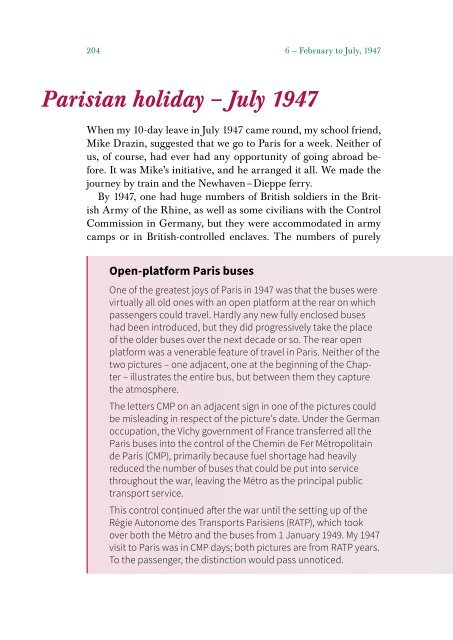Roger Atkinson - Blackout, Austerity and Pride
Blackout, Austerity and Pride – Life in the 1940s is a book written primarily from actual experience. It tells how an alert and intelligent boy, effectively orphaned at the age of 13, sets out to gain a foothold in life. Aided by some resourceful women, he unites a thirst for knowledge with a growing passion for places and buses and a strong sense of duty. http://www.memoir1940s.org.uk/
Blackout, Austerity and Pride – Life in the 1940s is a book written primarily from actual experience. It tells how an alert and intelligent boy, effectively orphaned at the age of 13, sets out to gain a foothold in life. Aided by some resourceful women, he unites a thirst for knowledge with a growing passion for places and buses and a strong sense of duty.
http://www.memoir1940s.org.uk/
You also want an ePaper? Increase the reach of your titles
YUMPU automatically turns print PDFs into web optimized ePapers that Google loves.
204 6 — February to July, 1947<br />
Parisian holiday – July 1947<br />
When my 10-day leave in July 1947 came round, my school friend,<br />
Mike Drazin, suggested that we go to Paris for a week. Neither of<br />
us, of course, had ever had any opportunity of going abroad before.<br />
It was Mike’s initiative, <strong>and</strong> he arranged it all. We made the<br />
journey by train <strong>and</strong> the Newhaven – Dieppe ferry.<br />
By 1947, one had huge numbers of British soldiers in the British<br />
Army of the Rhine, as well as some civilians with the Control<br />
Commission in Germany, but they were accommodated in army<br />
camps or in British-controlled enclaves. The numbers of purely<br />
Open-platform Paris buses<br />
One of the greatest joys of Paris in 1947 was that the buses were<br />
virtually all old ones with an open platform at the rear on which<br />
passengers could travel. Hardly any new fully enclosed buses<br />
had been introduced, but they did progressively take the place<br />
of the older buses over the next decade or so. The rear open<br />
platform was a venerable feature of travel in Paris. Neither of the<br />
two pictures – one adjacent, one at the beginning of the Chapter<br />
– illustrates the entire bus, but between them they capture<br />
the atmosphere.<br />
The letters CMP on an adjacent sign in one of the pictures could<br />
be misleading in respect of the picture’s date. Under the German<br />
occupation, the Vichy government of France transferred all the<br />
Paris buses into the control of the Chemin de Fer Métropolitain<br />
de Paris (CMP), primarily because fuel shortage had heavily<br />
reduced the number of buses that could be put into service<br />
throughout the war, leaving the Métro as the principal public<br />
transport service.<br />
This control continued after the war until the setting up of the<br />
Régie Autonome des Transports Parisiens (RATP), which took<br />
over both the Métro <strong>and</strong> the buses from 1 January 1949. My 1947<br />
visit to Paris was in CMP days; both pictures are from RATP years.<br />
To the passenger, the distinction would pass unnoticed.


















